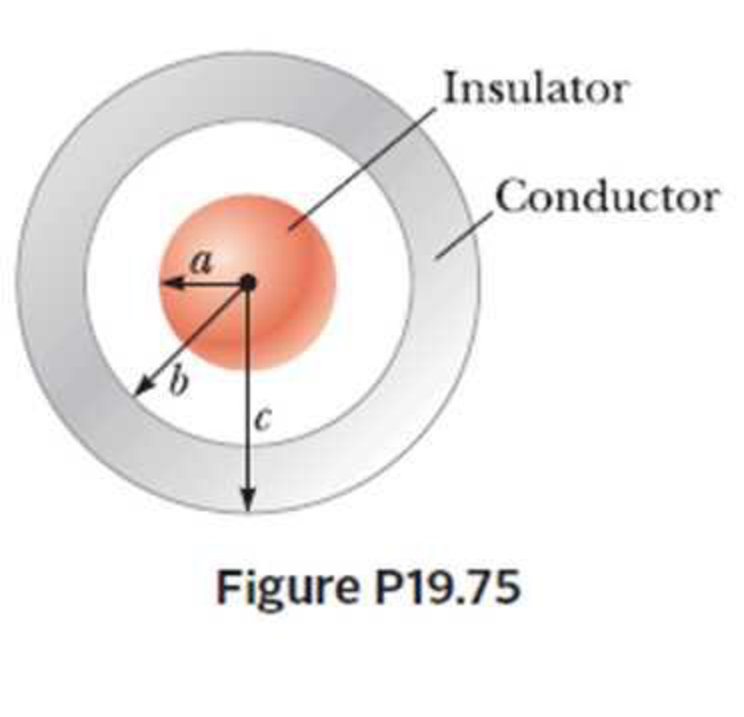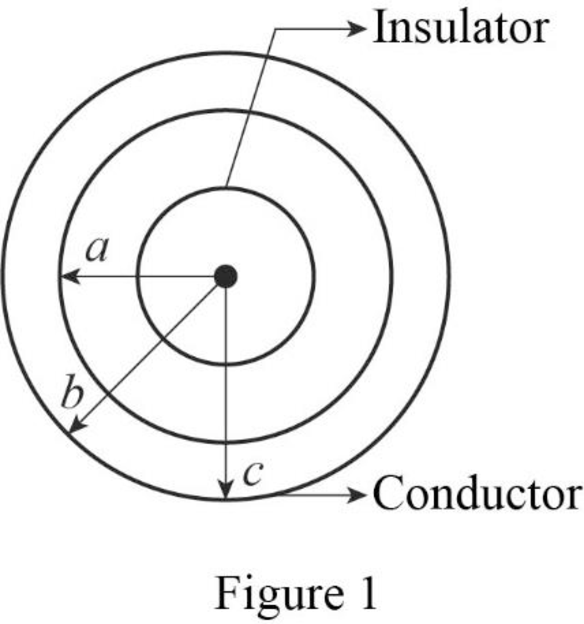
Concept explainers
A solid, insulating sphere of radius a has a uniform charge density throughout its volume and a total charge Q. Concentric with this sphere is an uncharged,

(a)
The charge enclosed by the Gaussian surface in the region
Answer to Problem 75P
The charge enclosed by the Gaussian surface in the region
Explanation of Solution
Figure 1 represents an insulating sphere of radius

Consider a Gaussian surface of radius
Write the expression for charge enclosed by the Gaussian surface in the region
Here,
Write the expression for volume enclosed by the Gaussian surface.
Here,
Use equation (II) in (I).
Write the expression for volume charge density for the insulating sphere of radius
Use equation (IV) in (III),to find
Conclusion:
Therefore, the charge enclosed by the Gaussian surface in the region
(b)
The electric field in the region
Answer to Problem 75P
The electric field in the region
Explanation of Solution
Write the expression for Gauss law.
Here,
Due to spherical symmetry, the element of area
From subpart (a), the charge enclosed in the region
Use equation (V) in (VII), and rearrange.
The above is written as
Here,
Conclusion:
Therefore, the electric field in the region
(c)
The charge enclosed by the Gaussian surface in the region
Answer to Problem 75P
The charge enclosed by the Gaussian surface in the region
Explanation of Solution
Write the expression for charge enclosed by the Gaussian surface in the region
Here,
Conclusion:
Therefore, charge enclosed by the Gaussian surface in the region
(d)
The magnitude of electric field in the region
Answer to Problem 75P
The magnitude of electric field in the region
Explanation of Solution
Write the expression for charge enclosed by the Gaussian surface in the region
Here,
Use equation (XI) in (VII).
The above equation is written as
Conclusion:
Therefore, the magnitude of electric field in the region
(e)
The magnitude of electric field in the region
Answer to Problem 75P
The magnitude of electric field in the region
Explanation of Solution
Write the expression for Gauss law.
The Gaussian surface encloses zero charge in the region
Write the expression for charge enclosed by the Gaussian surface in the region
Here,
Use equation (XIII) in (VI).
Conclusion:
Therefore, the magnitude of electric field in the region
(f)
The charge on the inner surface of the hollow sphere.
Answer to Problem 75P
The charge on the inner surface of the hollow sphere is
Explanation of Solution
Write the expression for Gauss law.
Write the expression for charge enclosed by the Gaussian surface.
Here,
Use equation (XIV) in (VI).
The electric field inside the conductor is zero, the charge enclosed by the Gaussian surface is zero. The above equation is reduced to
Conclusion:
Therefore, the charge on the inner surface of the hollow sphere is
(g)
The charge on the outer surface of the hollow sphere.
Answer to Problem 75P
The charge on the outer surface of the hollow sphere is
Explanation of Solution
Write the expression for total charge inside the hollow sphere.
Here,
The total charge inside the conductor is zero, the above equation is reduced to
Rearrange the above equation, to find
Conclusion:
Substitute
Therefore, The charge on the outer surface of the hollow sphere is
(h)
Among the three spherical surfaces having radii
Answer to Problem 75P
The inner surface of radius
Explanation of Solution
Write the expression for surface charge density.
Here,
The solid insulating sphere has small surface charge density since its total charge is uniformly distributed throughout its volume.
The inner surface of the hollow cylinder with radius
Conclusion:
Therefore, the inner surface of radius
Want to see more full solutions like this?
Chapter 19 Solutions
Bundle: Principles of Physics: A Calculus-Based Text, 5th + WebAssign Printed Access Card for Serway/Jewett's Principles of Physics: A Calculus-Based Text, 5th Edition, Multi-Term
- please answer this asap!!!!arrow_forwardRT = 4.7E-30 18V IT = 2.3E-3A+ 12 38Ω ли 56Ω ли r5 27Ω ли r3 28Ω r4 > 75Ω r6 600 0.343V 75.8A Now figure out how much current in going through the r4 resistor. |4 = unit And then use that current to find the voltage drop across the r resistor. V4 = unitarrow_forward7 Find the volume inside the cone z² = x²+y², above the (x, y) plane, and between the spheres x²+y²+z² = 1 and x² + y²+z² = 4. Hint: use spherical polar coordinates.arrow_forward
- ганм Two long, straight wires are oriented perpendicular to the page, as shown in the figure(Figure 1). The current in one wire is I₁ = 3.0 A, pointing into the page, and the current in the other wire is 12 4.0 A, pointing out of the page. = Find the magnitude and direction of the net magnetic field at point P. Express your answer using two significant figures. VO ΜΕ ΑΣΦ ? Figure P 5.0 cm 5.0 cm ₁ = 3.0 A 12 = 4.0 A B: μΤ You have already submitted this answer. Enter a new answer. No credit lost. Try again. Submit Previous Answers Request Answer 1 of 1 Part B X Express your answer using two significant figures. ΜΕ ΑΣΦ 0 = 0 ? below the dashed line to the right P You have already submitted this answer. Enter a new answer. No credit lost. Try again.arrow_forwardAn infinitely long conducting cylindrical rod with a positive charge λ per unit length is surrounded by a conducting cylindrical shell (which is also infinitely long) with a charge per unit length of −2λ and radius r1, as shown in the figure. What is σinner, the surface charge density (charge per unit area) on the inner surface of the conducting shell? What is σouter, the surface charge density on the outside of the conducting shell? (Recall from the problem statement that the conducting shell has a total charge per unit length given by −2λ.)arrow_forwardA small conducting spherical shell with inner radius aa and outer radius b is concentric with a larger conducting spherical shell with inner radius c and outer radius d (Figure 1). The inner shell has total charge +2q, and the outer shell has charge −2q. What's the total charge on the inner surface of the small shell? What's the total charge on the outer surface of the small shell? What's the total charge on the inner surface of the large shell? What's the total charge on the outer surface of the large shell?arrow_forward
 College PhysicsPhysicsISBN:9781938168000Author:Paul Peter Urone, Roger HinrichsPublisher:OpenStax College
College PhysicsPhysicsISBN:9781938168000Author:Paul Peter Urone, Roger HinrichsPublisher:OpenStax College Principles of Physics: A Calculus-Based TextPhysicsISBN:9781133104261Author:Raymond A. Serway, John W. JewettPublisher:Cengage Learning
Principles of Physics: A Calculus-Based TextPhysicsISBN:9781133104261Author:Raymond A. Serway, John W. JewettPublisher:Cengage Learning Physics for Scientists and Engineers: Foundations...PhysicsISBN:9781133939146Author:Katz, Debora M.Publisher:Cengage Learning
Physics for Scientists and Engineers: Foundations...PhysicsISBN:9781133939146Author:Katz, Debora M.Publisher:Cengage Learning Physics for Scientists and Engineers with Modern ...PhysicsISBN:9781337553292Author:Raymond A. Serway, John W. JewettPublisher:Cengage Learning
Physics for Scientists and Engineers with Modern ...PhysicsISBN:9781337553292Author:Raymond A. Serway, John W. JewettPublisher:Cengage Learning College PhysicsPhysicsISBN:9781305952300Author:Raymond A. Serway, Chris VuillePublisher:Cengage Learning
College PhysicsPhysicsISBN:9781305952300Author:Raymond A. Serway, Chris VuillePublisher:Cengage Learning Physics for Scientists and EngineersPhysicsISBN:9781337553278Author:Raymond A. Serway, John W. JewettPublisher:Cengage Learning
Physics for Scientists and EngineersPhysicsISBN:9781337553278Author:Raymond A. Serway, John W. JewettPublisher:Cengage Learning





